
Ossetians
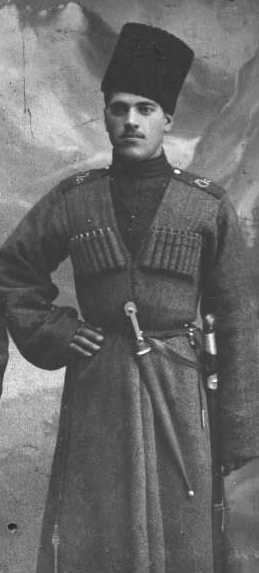 Ossetia is divided into two distinct areas. In 1917-1921, North Ossetia was in Russia, and South Ossetia was in Georgia.
Ossetia is divided into two distinct areas. In 1917-1921, North Ossetia was in Russia, and South Ossetia was in Georgia.
When Georgia split off from the rest of the Tsarist Empire in 1918, the Ossetian minority also made a break for autonomy. There was a nasty little war which the Ossetians lost, and the province remained part of Georgia until the Red Army conquered it in early 1921 (the Soviets using unrest in South Ossetia as part of their excuse for their invasion).
North Ossetia includes the major city of Vladikavkaz, and also Mozdok, so was a centre for Soviet power in the Caucasus. The countryside was however heavily settled by Terek Cossacks. The result was that it was extremely turbulent until conquered by the Volunteer Army in the Second Kuban Campaign. After that it was one of the more settled parts of the Caucasus, relatively speaking.
The Ossetians differ from the other Caucasian tribes in largely being Christian, though there is a small Moslem minority. Because of this, and because their political views about Georgia aligned with that of Denikin, the Ossetians fought in much larger numbers for the Whites than the other Caucasian tribes.
1st and 3rd Ossetian Horse Regiments
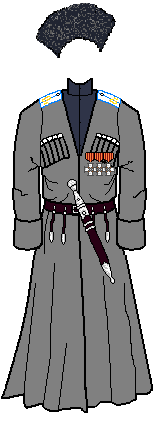 |
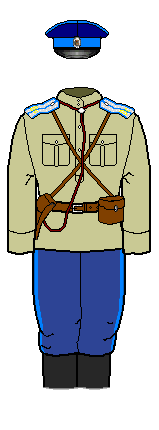 |
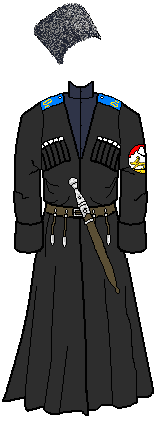 |
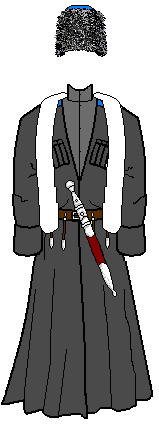 |
| Captain, with St George medals | Officer: non-Caucasian dress | Trooper: wartime dress with Ossetian badge | Trooper: with plain bashlyk |
This is the uniform from prior to WWI. The distinguishing colour was "light blue". Since they were said to wear the same uniform as the Terek Cossacks, we have assume that the blue is basically the same.
We know that at least a couple of the Ossetian units' senior officers during the RCW were Russian, and they might have chosen not to wear Caucasian dress.
Uniform Details
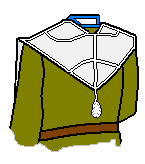 |
 |
 |
|---|---|---|
| Ossetian Bashlyk: white, with white trim. | Shoulderboards in WWI | Ossetian hats: cross for officers and plain for men |
Buttons were silver and officers had silver lace. Cavalry officer ciphers and rank markings were in gold. Khaki shoulderboards were stencilled in light blue.
Presumably with the expansion to multiple regiments in the Civil War the cipher gained a leading number.
History in the RCW
There had been an Ossetian Horse Regiment in the Russian Imperial Army prior to WWI. They did not have a regiment in the Savage Division.
The 1st Native Horse Regiment, which was in Colonel Shkuro's detachment of the Volunteer Army, had an Ossetian Divizion as early as September 1918.
In February 1919 an Ossetian Horse Division was formed, consisting of the 1st to 4th Ossetian Horse Regiments. This fought as part of the Forces of the Northern Caucasus. However the 3rd Regiment was sent within a month to the Combined Mountain Horse Division.
In May 1919 the Division gained the 1st to 3rd Ossetian Rifle Battalions, but the 1st Battalion was soon sent to the Volunteer Army, where it joined the 3rd Ossetian Horse Regiment.
The Ossetian Division, still in the Forces of the North Caucasus in October 1919 was counted as:
Brigade Commander – Col Emmanuel
1st Ossetian Horse Regiment – Col. Belikov – 265 sabres, 5 MGs
2nd Ossetian Horse Regiment – Col. Gutiev – 244 sabres, 8 MGs
4th Ossetian Horse Regiment – Col. Khabaev – 93 sabres, 8 MGs
2nd Ossetian Rifle Battalion – Col. Tkhostov – 308 rifles, 4 MGs
3rd Ossetian Rifle Battalion – Col. Granat – 384 rifles, 4 MGs
In 1920 the bulk of the Ossetian Division retreated from the Astrakhan area to Georgia.
Meanwhile the 3rd Ossetian Horse Regiment and 1st Ossetian Rifle Battalion had been fighting in the Ukraine with the Volunteer Army. In March, during the retreat, they were combined into a Combined Ossetian Division under Colonel M.A. Dzaghinov and took part in the "Bredov March" to Poland.
The remnants of this new Ossetian Division were grouped into the 1st Native Horse Regiment on their repatriation to the Crimea, but this was disbanded in August 1920. It is possible some of the men formed a squadron in one of the cavalry regiments of the reformed 1st Cavalry Division, but we have no information on this.
Other Units
There was an Ossetian Sotnia in the Forces of the Trans-Caspia (modern Turkestan), numbering 68 men and one MG in October 1919.
As well as the Ossetian Horse Division, the Forces of the North Caucasus at some time recruited some more Ossetians. In October 1919 they had a Detached Ossetian Divizion of 78 sabres and another Ossetian Horse Divizion of 46 sabres and one machine-gun.
The uniform of the Ossetians is more or less identical to that of the Terek Cossacks (apart from the bashlyk), which does allow units painted this way to be used in the 1920 Northern Tauridia campaign as Terek Cossacks.
Infantry units would wear the same dress, except officer markings would be in silver, and khaki shoulderboards probably would be marked in yellow. As there was a shortage of local infantry officers, it would seem likely that they were commanded by Russians (the names above certainly suggest so) who may have prefered standard infantry dress.
Photos
We have collected various period photos of mountaineers on a separate page.